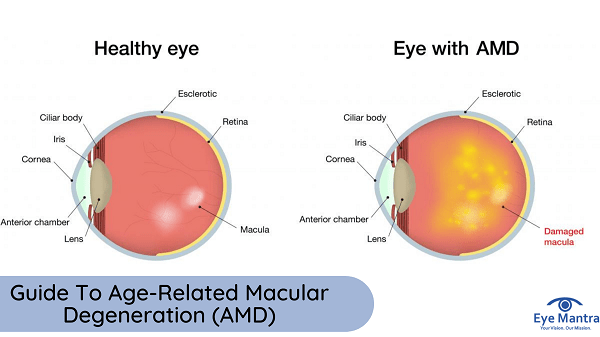
Age–Related Macular Degeneration (AMD) is the most common explanation for severe loss of eyesight among people who are above 50 years of age. Only the middle vision is affected by this disease And it’s important to understand that folks rarely go blind from it.
AMD affects the sight and with it, the power to ascertain fine details. In AMD, a tiny middle portion of the retina called “macula” wears down. In advanced stages, people lose their ability to drive, to recognize faces, and to read texts in smaller prints. In its early stages, AMD may not show any signs or symptoms, so people might not suspect that they are even suffering from it.
Contents
The two primary kinds of age-related macular degeneration, which have been mentioned below:-
There are several risk factors which contributes to the development of age-related macular degeneration, including:
The following are the foremost common symptoms of age-related macular degeneration. However, each individual may experience symptoms differently. Symptoms may include:
The presence of “drusen”, is one of the most common early signs of age-related macular degeneration. “Drusen” are tiny yellow deposits within the retina. Their occurrence means that the person is in danger of developing more severe age-related macular degeneration. These tiny yellow deposits are going to be visible to your doctor during an eye exam.
In addition to analysis of your entire medical record and a thorough eye exam, your ophthalmologist may do the subsequent tests to diagnose age-related macular degeneration:
Visual acuity test:- This common chart test measures vision ability at various distances.
Pupil dilation. The pupil is widened with certain eye drops to permit a close-up examination of the eye’s retina.
Fluorescein angiography:- This diagnostic test involves a special dye injected into a vein within the arm. Pictures are then taken because the dye passes through the blood vessels within the retina, helping the doctor evaluate if the blood vessels are leaking.
Amsler grid.
This test uses a checkerboard-like grid to work out if the straight lines within the pattern appear wavy or missing to the patient. Both indications may signal the likelihood of age-related macular degeneration.
To use this, follow these steps:
Wear any glasses you normally use to read, hold the grid twelve to fifteen inches far away from your face in a good light.
Cover one eye.
Look directly at the middle dot with your uncovered eye and keep your eye focused thereon.
While looking directly at the middle dot, notice in your side vision if all grid lines look straight or if any lines or areas look blurry, wavy, dark, or blank.
Follow the same steps with the opposite eye.
If you notice any areas of the grid that appear darker, wavy, blank, or blurry, contact your ophthalmologist directly.
Specific treatment for Age-Related macular degeneration is going to be determined by your doctor based on:
Currently, there is no treatment for dry age-related macular degeneration, though vision rehabilitation programs and low-vision devices are often used to “build visual skills and develop new ways to perform daily activities”.
The main treatment for wet AMD is the injection of medicines called anti-VEGF agents. VEGF stands for vascular endothelial protein. A high level of VEGF within the eye is linked to the formation of the abnormal blood vessels. Anti-VEGF agents combat the disease process and reduce the damaging effects of those leaky abnormal blood vessels. They also effectively stabilize vision in many patients.
In some patients, anti-VEGF injections improve the extent of visual acuity. Anti-VEGF medications are administered by injecting them directly into the affected eye. Anti-VEGF treatment is typically administered regularly over time, requiring multiple injections for the treatment to take effect, and your retinal physician will discuss the simplest treatment method for you. In selected patients, other treatments, like laser therapy are often used.
We also offer various services like Retina Surgery, Specs Removal, Lasik Surgery, Squint, Cataract Surgery, Glaucoma surgery, and much more.
[video_lightbox_youtube video_id=”OSOCarxu8Rg” width=”1200″ height=”800″ auto_thumb=”1″]